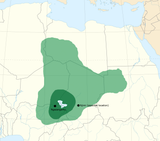Search Results
8/3/2025, 2:59:43 PM
>>17893216
>The Kanem–Bornu Empire's active contact with North Africa resulted not only in trade and diplomacy, but also garnered the empire some cosmopolitan influence and contacts.[81] The empire had considerable influence in its overall region, with both Nguzargamu[36] and the later Kukawa having been important centers in the Sudan region.[50] At the height of the Sayfawa dynasty's rule, the safety provided by the state and the firm grasp it had on the trade routes led to a common saying that even "a lone woman clad in gold might walk with none to fear but God".[81] Although imperial power gradually declined over the course of its last centuries, the empire continued to hold symbolic importance among its neighbors. In 1800, virtually all of Hausaland was still nominally tributaries of the empire and sent annual gifts to the mai.
>The agriculture of the empire was probably similar to the agriculture of the region today. Crops were planted at the beginning of the rainy season (June–October). The main crops were varities of guinea corn and millet.
>The Kanem–Bornu Empire's active contact with North Africa resulted not only in trade and diplomacy, but also garnered the empire some cosmopolitan influence and contacts.[81] The empire had considerable influence in its overall region, with both Nguzargamu[36] and the later Kukawa having been important centers in the Sudan region.[50] At the height of the Sayfawa dynasty's rule, the safety provided by the state and the firm grasp it had on the trade routes led to a common saying that even "a lone woman clad in gold might walk with none to fear but God".[81] Although imperial power gradually declined over the course of its last centuries, the empire continued to hold symbolic importance among its neighbors. In 1800, virtually all of Hausaland was still nominally tributaries of the empire and sent annual gifts to the mai.
>The agriculture of the empire was probably similar to the agriculture of the region today. Crops were planted at the beginning of the rainy season (June–October). The main crops were varities of guinea corn and millet.
Page 1
